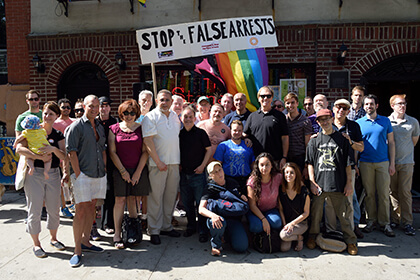A majority of organizations serving as LGBTQ safe spaces around the country experienced harassment or violence in 2022 and roughly half say they endured at least one incident of online harassment, according to a nationwide survey of queer safe spaces from all 50 states and Washington, DC.
The survey — prompted by the Club Q shooting in Colorado Springs — sought to measure the amount of hate targeting LGBTQ organizations in 2022. The survey was led by the New York City Anti-Violence Project (AVP) in partnership with the Arcus Foundation and Wellspring Philanthropic Fund, Center Link, the Equality Federation, Strength in Numbers Consulting Group, Bryce Celotto, and Swarm Strategy.
Roughly a quarter of the organizations participating in the survey were health or social service agencies, while 22% were community centers, 16% were LGBTQ-friendly houses of worship, 15% were LGBTQ groups, 12% were LGBTQ centers at colleges and universities, and 9% were LGBTQ businesses. Another 4.6% represented groups serving as cultural institutions featuring LGBTQ programming. All in all, nearly 400 businesses and organizations took part in the survey, which was conducted between December 13 of last year and March 31 of this year.
“In the wake of the Club Q shooting, there was a lot of fear and vicarious trauma in our communities, and folks were concerned if such violence would happen in their spaces,” said Catherine Shugrue dos Santos, deputy executive director of programs for AVP and collaborator/editor of the report. “Organizations need more resources to be able to keep themselves and the communities who seek solace within them safer, and the climate for these organizations is worsening. All of this motivated AVP to act quickly on a national level to bring awareness to this issue, by going directly to LGBTQ+ safe spaces and asking them what was happening to them in this moment, and what they need now to be safer.”
Among other takeaways, about half of all the organizations experienced at least one incident of online harassment and 36% of the organizations experienced publicly posted harassment on a social media platform. Online harassment is the most commonly experienced, according to the research.
Furthermore, 37.1% of organizations experienced both online and phone or in-person incidents, and those events were not just “one-off occurrences.” In the survey, 28.8% of the businesses and organizations experienced two or more different types of harassment and 8.7% experienced four or more.
According to the study, the two most highly targeted groups were groups serving youth as well as LGBTQ+ community centers. Youth-serving organizations were more likely to come across counter-protestors (30.3%), and 86.8% of LGBTQ+ community centers experienced at least one phone or in-person incident.
Nearly half of all groups that experienced protests believed that the protestors were from white nationalist groups.
However, despite this harassment, police reporting was inconsistent, according to the survey. Reports were often only made when organizations and businesses believed there would be definitive future physical harm. Less than half of groups knew of a police report filed in response to violence, and nearly half of groups that did report to police said law enforcement did not file a report or investigate the case. Many said the reason why they did not go to police was because of the perception that they would face bias or harassment from law enforcement.
Some survey participants said they would be more likely to report an incident if they could communicate with an LGBTQ-affirming officer.
Shugrue dos Santos, who also serves as a senior lecturer at Columbia University School of Social Work, stressed that the effort to combat violence must include combating hate. AVP, Shugrue dos Santos said, uses the term “hate violence” to include acts that may not be criminalized, like protests, but have harmful or threatening intent behind them. That, in turn, provides a broader picture of the state of homophobia and transphobia.
“As a nation, we must shift our culture and fully reject this hatred that leads to violence, even when the expression of that hatred is protected speech,” Shugrue dos Santos said. “It takes all of us to do this work in a community, where real change can happen.”
As for the future, 68% of those who were surveyed said they were worried about online harassment, while 54.2% expressed concern about harassment outside of their space. Almost 90% of those surveyed conveyed that they “want at least one security measure that they do not have.”
Safety protocols were least likely to be in place among small organizations (usually with 1-10 staff members), while 84% of organizations with 25 or more staff members had safety protocols in place. A large reasoning behind the lack of safety protocols for small organizations and businesses was lack of resources.
Researchers called on the LGBTQ community to develop creative and impactful responses to hate violence that strengthen queer people while also advancing long-term prevention strategies.
“We want to see more investment in security, safety, and programming for LGBTQ+ organizations, from the government and private industry,” Shugrue dos Santos said. “We want to see more calling out of the hateful rhetoric becoming more pervasive in our society, and we must drive hate groups back into the dark. We also, as communities, must rise against hateful legislation which only emboldens bad actors to harm us, and we must move toward a society that allows LGBTQ+ people to live freely.”


































